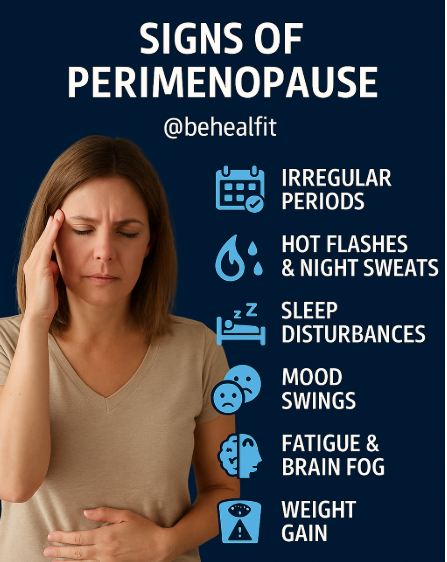How to Know If You’re in Perimenopause
Discover the signs and symptoms of perimenopause, the transitional phase before menopause. Learn how to recognize the early indicators and support your health during this time.
HEALTHBLOG-LISTWELLNESS
Narcisse Bosso
8/24/20252 min read


In Brief
Perimenopause is a natural phase that precedes menopause and can start as early as the late 30s or early 40s. It usually lasts several years and is marked by significant hormonal fluctuations. These changes bring physical and emotional symptoms that vary from woman to woman. Recognizing them helps anticipate and better manage this transition.
Table of Contents
What Is Perimenopause?
The Most Common Signs of Perimenopause
Changes in the Menstrual Cycle
Hot Flashes and Night Sweats
Sleep Disturbances
Mood Swings and Anxiety
Persistent Fatigue and Brain Fog
Weight Gain and Slower Metabolism
At What Age Does Perimenopause Start?
How to Confirm Perimenopause
FAQ
Conclusion
What Is Perimenopause?
Perimenopause is the hormonal transition leading up to menopause. It is characterized by a gradual decline in estrogen and progesterone, two key reproductive hormones. This phase can last anywhere from 4 to 10 years before menstruation fully stops.
👉 Also read: Perimenopause Symptoms.
The Most Common Signs of Perimenopause
1. Changes in the Menstrual Cycle
Periods become irregular: cycles may shorten or lengthen, and flow can be heavier or lighter.
2. Hot Flashes and Night Sweats
These classic symptoms are linked to hormonal fluctuations that affect temperature regulation.
3. Sleep Disturbances
Difficulty falling asleep or staying asleep, often worsened by night sweats.
4. Mood Swings and Anxiety
Lower estrogen impacts serotonin, leading to irritability, anxiety, or even depressive episodes.
5. Persistent Fatigue and Brain Fog
A constant feeling of tiredness, often accompanied by memory lapses and reduced concentration.
6. Weight Gain and Slower Metabolism
Hormonal decline encourages fat storage, particularly around the abdomen.
At What Age Does Perimenopause Start?
Perimenopause usually begins between ages 40 and 50, but it can start earlier — as young as 35–38 years old in some women. The average duration is 4 to 7 years, leading up to menopause (defined as 12 consecutive months without periods).
How to Confirm Perimenopause
Diagnosis is based primarily on symptoms and sometimes on hormone tests (FSH, estradiol). However, since hormone levels can fluctuate monthly, perimenopause is mostly a clinical diagnosis. Medical follow-up is recommended to rule out other causes.
👉 Also read: How to Boost Memory and Focus with Essential Oils.
FAQ
1. Is perimenopause the same as menopause?
No. Perimenopause is the transition leading up to menopause. It ends once a woman has gone 12 consecutive months without periods.
2. Can you still get pregnant during perimenopause?
Yes, ovulation is still possible, though less regular.
3. What tests can confirm perimenopause?
Hormone tests may be used, but symptom tracking remains the most reliable method.
4. Do all women experience the same symptoms?
No. Every woman’s perimenopause experience is unique. Some feel very few symptoms, while others experience many.
5. Are there natural solutions to support perimenopause?
Yes: a balanced diet, physical activity, stress management, and herbal remedies (soy, black cohosh, etc.) can help.
Conclusion
Perimenopause is a natural stage in women’s lives, but it can be confusing due to its wide range of symptoms. Learning how to recognize them makes it easier to prepare and adopt habits that support health and well-being.
💡 Action step: Start a journal to track your cycles and symptoms, it will help you understand your body better and have more meaningful discussions with your doctor.
Scientific Sources
Mayo Clinic. Perimenopause: Symptoms and Causes.
World Health Organization (WHO). Women’s Health and Hormonal Changes.
Harvard Health Publishing. Perimenopause: Rocky road to menopause.
Written by Narcisse Bosso, certified naturopath. His lifelong passion for health became a profound calling after a loved one passed away from a natural illness that could have been prevented with simple lifestyle changes and habits.
